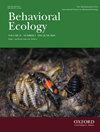How does viewing angle affect the perceived accuracy of Batesian mimicry in hoverflies?
IF 2.2
3区 环境科学与生态学
Q2 BEHAVIORAL SCIENCES
引用次数: 0
Abstract
Despite Batesian mimicry often eliciting predator avoidance, many Batesian mimics, such as some species of hoverfly (Syrphidae), are considered to have an “imperfect” resemblance to their model. One possible explanation for the persistence of apparently imperfect mimicry is that human perceptions of mimicry are different from those of natural predators. Natural predators of hoverflies have different visual and cognitive systems from humans, and they may encounter mimics in a different way. For example, whilst humans often encounter hoverflies at rest on vegetation, or in photographs or textbooks, where they are typically viewed from above, natural predators may approach hoverflies from the side or below. To test how viewing angle affects the perception of mimicry, images of mimetic hoverflies and their models (wasps and bees) were shown from different angles in an online survey. Participants were asked to distinguish between the images of models and mimics. The results show that the viewing angle does affect perceived mimicry in some species, although it does not provide a complete explanation for the persistence of imperfect mimicry in nature. The effect is also highly species-specific. This suggests that to understand better how selection has shaped mimetic accuracy in hoverflies and other taxa, further study is required of the viewing angles that predators utilize most commonly in nature.观察角度如何影响食蚜蝇贝氏拟态的准确性?
尽管贝茨拟态常常会引起捕食者的回避,但许多贝茨拟态,如某些种类的食蚜蝇(Syrphidae),被认为与其拟态有 "不完美 "的相似之处。表面上看似不完美的拟态之所以持续存在,一个可能的解释是人类对拟态的看法与天敌的看法不同。食蚜蝇的天敌拥有与人类不同的视觉和认知系统,它们可能会以不同的方式遇到拟态。例如,人类通常会在植被上、照片或教科书中遇到静止的食蚜蝇,它们通常是从上方观看的,而天敌可能会从侧面或下方接近食蚜蝇。为了测试观察角度如何影响对拟态的感知,我们在一项在线调查中从不同角度展示了拟态食蚜蝇及其模型(黄蜂和蜜蜂)的图像。参与者被要求区分模型和拟态的图像。结果表明,在某些物种中,观看角度确实会影响感知到的拟态,但这并不能完全解释自然界中持续存在的不完全拟态。这种影响还具有高度的物种特异性。这表明,要想更好地理解选择是如何塑造食蚜蝇和其他类群的拟态准确性的,还需要进一步研究捕食者在自然界中最常使用的观察角度。
本文章由计算机程序翻译,如有差异,请以英文原文为准。
求助全文
约1分钟内获得全文
求助全文
来源期刊

Behavioral Ecology
环境科学-动物学
CiteScore
5.20
自引率
8.30%
发文量
93
审稿时长
3.0 months
期刊介绍:
Studies on the whole range of behaving organisms, including plants, invertebrates, vertebrates, and humans, are included.
Behavioral Ecology construes the field in its broadest sense to include 1) the use of ecological and evolutionary processes to explain the occurrence and adaptive significance of behavior patterns; 2) the use of behavioral processes to predict ecological patterns, and 3) empirical, comparative analyses relating behavior to the environment in which it occurs.
 求助内容:
求助内容: 应助结果提醒方式:
应助结果提醒方式:


